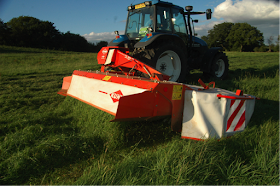With peak silage-making season upon us, farmers are being urged to focus on the process to minimise the threat of moulds and potential multiple mycotoxin contamination in their conserved forage. Despite the recent cooler than average weather for this time of year, silage making has started early. For good quality and quantity of silage, farmers are advised to cut and ensile grass correctly to minimise the risk of aerobic deterioration, mould development and multiple mycotoxin contamination.
Farmers are advised to base their mowing on current soil and crop conditions.
“Mow when the grass is dry. If your sward is open or there is a lot of dead material in the base of the grass – because of lodging or aftermath from last autumn perhaps – increase your cutting height to 7.5-10 cm,” advised Dr. David Davies of Silage Solutions, an independent British silage consultancy agency.
“The main rational behind this is moulds such as penicillium live on low-lying dead and decaying plant material. Spread the cut grass to encourage a rapid wilt, too, because wilting has a significant depressing effect on grass microbial composition.”
However, Davies stresses that good compaction of the crop in the clamp is the most important step farmers can take this year.
“Oxygen is the Achilles’ heel of silage production, and the key objective is to minimise the extent of aerobic spoilage in your clamp,” Davies advised.
Compacting even layers of grass no more than 15 cm deep in the clamp can reduce the amount of oxygen trapped in the crop. This action will minimise the level of yeast and mould growth, and ultimately the risk of mycotoxin contamination during storage. It is very important to seal the clamp properly, at the sides, on the top and the ramp.
Lauren Dimmack, Alltech animal health specialist, concurred with Davies.
“After opening, you want to make sure the clamp face remains solid, and if you can push your fingers in, it is not packed densely enough,” she advised.
If farmers have had problems with storage mycotoxins in the past, Alltech can undertake free on-farm risk assessments as part of the Alltech Mycotoxin Management programme. These assessments can help to identify any weakness in the feed process.
“Mycotoxins are responsible for numerous undiagnosed health issues in European dairy and beef cattle, even when growing and harvesting conditions are reasonable,” Dimmack said. “The symptoms will be many and varied, but the outcome in all cases will be reduced animal performance and lost profits. It is now more important than ever to implement a mycotoxin control programme to ensure the health of your animals, the quality of their feed and the security of our food supply.”
Visit the Alltech site HERE.
Farmers are advised to base their mowing on current soil and crop conditions.
“Mow when the grass is dry. If your sward is open or there is a lot of dead material in the base of the grass – because of lodging or aftermath from last autumn perhaps – increase your cutting height to 7.5-10 cm,” advised Dr. David Davies of Silage Solutions, an independent British silage consultancy agency.
“The main rational behind this is moulds such as penicillium live on low-lying dead and decaying plant material. Spread the cut grass to encourage a rapid wilt, too, because wilting has a significant depressing effect on grass microbial composition.”
 |
| To minimise the risk of mycotoxins in the silage clamp, cut grass depending on soil and crop conditions. |
“Oxygen is the Achilles’ heel of silage production, and the key objective is to minimise the extent of aerobic spoilage in your clamp,” Davies advised.
Compacting even layers of grass no more than 15 cm deep in the clamp can reduce the amount of oxygen trapped in the crop. This action will minimise the level of yeast and mould growth, and ultimately the risk of mycotoxin contamination during storage. It is very important to seal the clamp properly, at the sides, on the top and the ramp.
Lauren Dimmack, Alltech animal health specialist, concurred with Davies.
“After opening, you want to make sure the clamp face remains solid, and if you can push your fingers in, it is not packed densely enough,” she advised.
If farmers have had problems with storage mycotoxins in the past, Alltech can undertake free on-farm risk assessments as part of the Alltech Mycotoxin Management programme. These assessments can help to identify any weakness in the feed process.
“Mycotoxins are responsible for numerous undiagnosed health issues in European dairy and beef cattle, even when growing and harvesting conditions are reasonable,” Dimmack said. “The symptoms will be many and varied, but the outcome in all cases will be reduced animal performance and lost profits. It is now more important than ever to implement a mycotoxin control programme to ensure the health of your animals, the quality of their feed and the security of our food supply.”
Visit the Alltech site HERE.
The Global Miller
This blog is maintained by The Global Miller staff and is supported by the magazine GFMT
which is published by Perendale Publishers Limited.
For additional daily news from milling around the world: global-milling.com

No comments:
Post a Comment